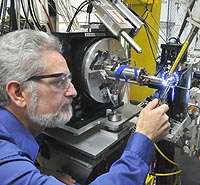Research could lead to more comprehensive flu vaccines

(PhysOrg.com) -- New findings from research performed on the influenza virus using X-rays generated by the Advanced Photon Source (APS) at the U.S. Department of Energy's Argonne National Laboratory may help pave the way for the development of a new, more effective vaccine that could combat a wide range of strains of the common and frequently deadly illness.
A group from the Scripps Research Institute in California used X-rays provided by the APS's National Institute of General Medical Sciences/National Cancer Institute Collaborative-Access Team (GM/CA-CAT) beamline to examine structures of the viral protein hemagluttinin from different strains of the virus, which were each bound to the same broadly neutralizing antibody. All forms of the flu virus contain hemagluttinin, which allows the flu virus to bind to infected cells, but the exact structure of the protein changes from strain to strain, which presents a great challenge for vaccine development.
Although the precise structure of hemagluttinin varies between different strains of the flu, parts of the protein are consistent throughout different strains. Influenza hemagluttinin contains two different principal subregions - a "head" and a "stalk." While different strains of the virus can have greatly different "heads," the "stalks" of different forms of hemagluttinin are largely the same.
Many antibodies bind to the non-conserved “head” regions of hemagluttinins, but these tend to be effective against only a limited range of viral strains. In this study, the researchers showed that a recently isolated, broadly neutralizing antibody bound to a conserved helical part of the “stalk” region of hemagluttinins from different strains of the virus. This result could allow researchers to tailor vaccines that would allow immunized patients to produce antibodies that would bind to the largely shared "stalk" regions of different viruses' hemagluttinin. Once the antibody binds to the stalk, the virus cannot change its conformation and infect the cell.
Current configurations of the flu vaccine inoculate recipients against three of the major influenza subtypes: the virus that caused the infamous Spanish flu of 1918 - which killed approximately 50 million people - as well as the viruses that caused the flu pandemics of 1957 and 1968. The research done at the Argonne could someday allows scientists and doctors to formulate a vaccine that protects not only against these strains but also against a broader range of variants, including the emerging threat of bird flu. "It would save a lot of lives to be able to protect the population against an incipient pandemic," said crystallographer Ian Wilson, who runs the Scripps laboratory that conducted the research.
The GM/CA-CAT beamline offered one particular advantage to the Scripps researchers. In addition to the highly focused high-energy X-rays provided to all of the beamlines at the APS, GM/CA-CAT has developed a unique triple collimator, which allows visiting scientists to opt whether to use the full X-ray beam or just a “minibeam” of only a few microns in diameter. The "minibeam" allows researchers either to examine exceptionally tiny crystals - down to a few microns in diameter - or to "walk along" the crystal by examining different points on it in order, and then using that data to reconstruct the larger picture. "This is a truly important study because it shows the value of large and complex machines in solving problems that impact the lives of thousands, if not millions, of people everyday," said Robert Fischetti, Associate Director of GM/CA-CAT.
GM/CA-CAT is funded by the National Cancer Institute and the National Institute of General Medical Sciences to operate national user facilities for crystallographic structure determination of biological macromolecules by X-ray diffraction.
More information: An electronic release based on the flu research appeared in the February 26 issue of Science Express and can be found online at www.sciencemag.org/cgi/rapidpdf/1171491.pdf . The paper version is in press.
Provided by Argonne National Laboratory














